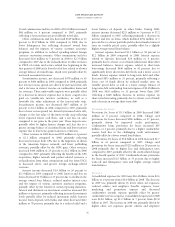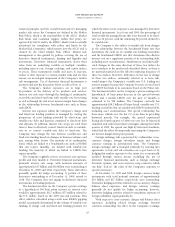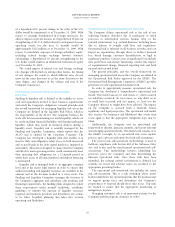American Express 2009 Annual Report Download - page 41
Download and view the complete annual report
Please find page 41 of the 2009 American Express annual report below. You can navigate through the pages in the report by either clicking on the pages listed below, or by using the keyword search tool below to find specific information within the annual report.
2009 FINANCIAL REVIEW
AMERICAN EXPRESS COMPANY
MasterCard networks, the American Express network does
not collectively set fees, antitrust actions and government
regulation of the bankcard networks’ pricing could ultimately
affect all networks.
In addition to the legislative and regulatory initiatives in
the United States regarding card practices and merchant fees,
other countries in which the Company operates have been
considering and in some cases adopting similar legislation and
rules that would impose changes on certain practices of card
issuers and bankcard networks, which could have a material
adverse effect on the Company’s results of operations.
CONSOLIDATED CAPITAL
RESOURCES AND LIQUIDITY
The Company’s balance sheet management objectives are to
maintain:
폷A solid and flexible equity capital profile;
폷A broad, deep and diverse set of funding sources to finance
its assets and meet operating requirements; and
폷Liquidity programs that enable the Company to satisfy all
maturing financing obligations for at least a 12 month
period should some or all of its funding sources become
inaccessible.
CAPITAL STRATEGY
The Company’s objective is to retain sufficient levels of capital
generated through earnings and other sources to maintain a
solid equity capital base and to provide flexibility to satisfy
future business growth. The Company believes capital
allocated to growing businesses with a return on risk-adjusted
equity in excess of its costs will generate shareholder value.
The level and composition of the Company’s equity capital
are determined in large part by the Company’s internal
assessment of its business activities, as well as rating agency
and regulatory capital requirements. They are also influenced
by subsidiary capital requirements, the business environment,
and by conditions in the debt capital markets. The Company,
as a bank holding company, is subject to regulatory
requirements administered by the U.S. federal banking
agencies. The Federal Reserve has established specific capital
adequacy guidelines that involve quantitative measures of
assets, liabilities, and certain off-balance sheet items.
The Financial Accounting Standards Board (FASB)
amended the accounting for off-balance sheet securitization
activities beginning January 1, 2010, which resulted in the
Company having to consolidate the assets (primarily
cardmember loans) and liabilities (primarily debt certificates)
of the American Express Credit Account Master Trust (the
Lending Trust). Both the cardmember loans and the debt will
be consolidated by American Express Travel Related Services
(TRS), a wholly-owned subsidiary of the Company and a
leading global payments and travel company, net of reserves
for expected credit losses.
The following table presents the regulatory risk-based
capital ratios and leverage ratio for the Company and its
significant banking subsidiaries, as well as some additional
ratios for the Company widely utilized in the marketplace, at
December 31, 2009. The respective pro forma ratios are also
presented, assuming the Lending Trust was consolidated in
the fourth quarter of 2009:
Well-
Capitalized
Ratio
2009
Actual
2009
ProForma
(a) (b)
Risk-Based Capital
Tier 1 6%
American Express Company 9.8% 8.6%
Centurion Bank 13.7% 13.7%
FSB 14.2% 14.2%
Total 10%
American Express Company 11.9% 10.8%
Centurion Bank 15.0% 15.0%
FSB 16.7% 16.7%
Tier 1 Leverage 5%
American Express Company 9.7% 7.0%
Centurion Bank 17.1% 17.1%
FSB 15.1% 15.1%
Tier 1 Common Risk-Based
American Express Company 4%(d) 9.8% 8.6%
Common Equity to Risk-
Weighted Assets(c)
American Express Company 12.4% 11.0%
Tangible common Equity to
Risk-Weighted Assets(c)
American Express Company 9.7% 8.4%
(a) Assumes the impact of the recognition of corresponding reserves
and other adjustments on the Company would be as follows:
Tangible common shareholders’ equity (TCE), common equity
and risk-weighted assets decreasing by $1.8 billion; Tier 1
common equity, Tier 1 capital and total capital decreasing by
$1.6 billion; and total average assets increasing by $23.7 billion.
(b) TRS will be the consolidating entity for the off-balance sheet
securitized trust (Lending Trust) and therefore there would be no
impact to the capital ratios of Centurion Bank and FSB.
(c) Common shareholders’ equity equals the Company’s
shareholders’ equity of $14.4 billion at December 31, 2009, and
TCE equals common shareholders’ equity, less goodwill and
intangibles of $3.0 billion. Risk-weighted assets at December 31,
2009, were $116.6 billion. The Company believes that presenting
the ratio of TCE to risk-weighted assets is a useful measure of
evaluating the strength of the Company’s capital position. See also
footnote (a) above.
(d) The regulatory benchmark of 4 percent was used within the
Supervisory Capital Assessment Program, conducted earlier in
2009.
39
























